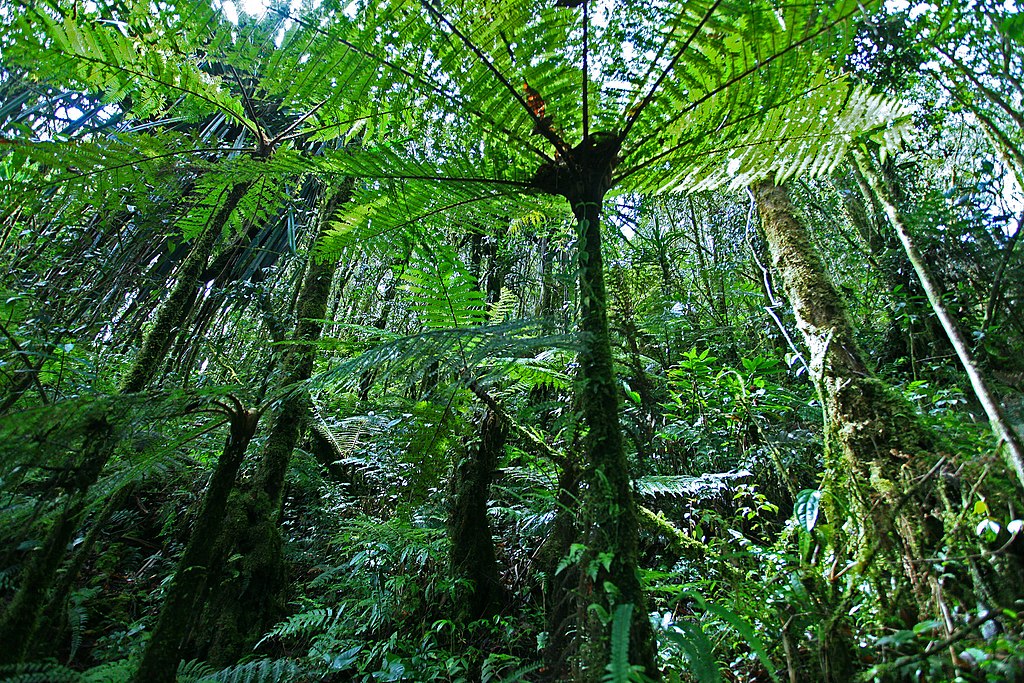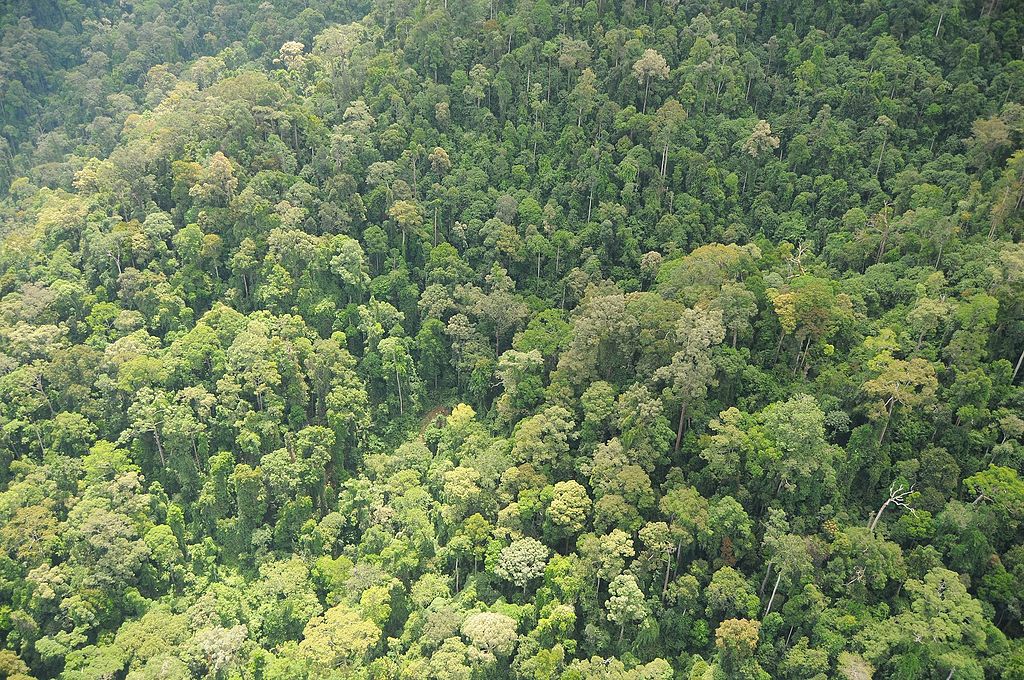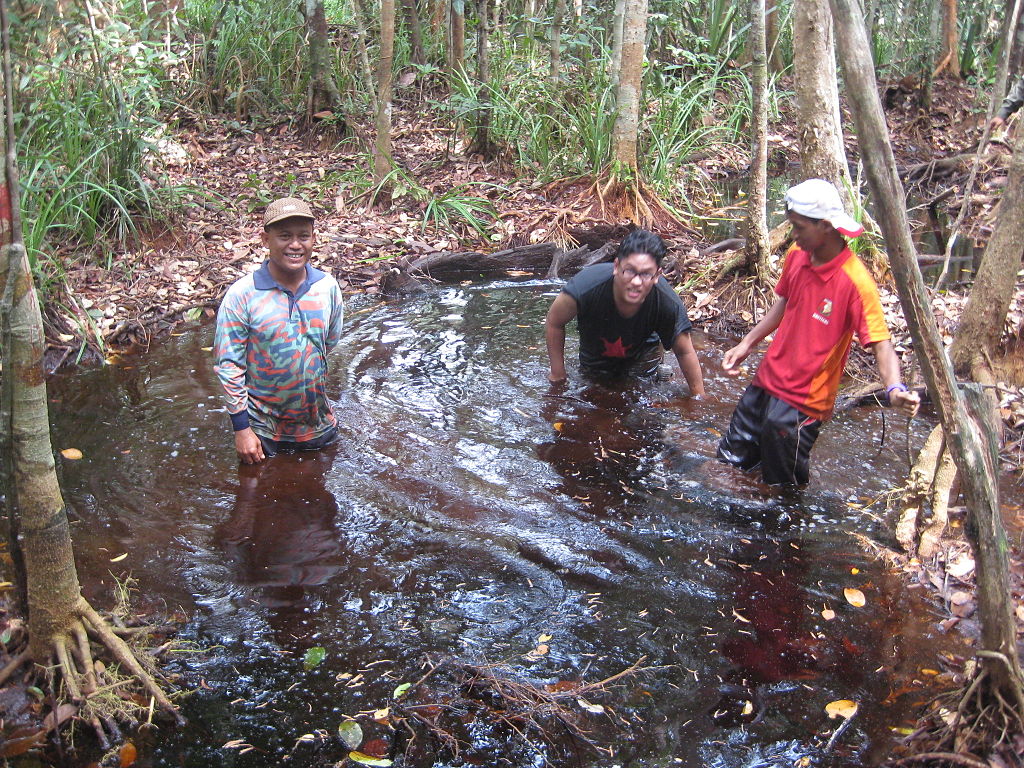Tropical rainforests are the most biologically diverse ecosystems on earth. While they cover just a small portion of the world’s surface, they're home to around 80% of its biodiversity.
Indonesia’s 88,496,000 hectares of forest represents 10% of the world’s remaining tropical forest, and are, despite massive levels of deforestation, the largest contiguous area of forest in Asia (FAO, 2009).
Tropical rainforests are found within 28 degrees north and south of the equator, and are characterized by constant warm temperatures and high levels of humidity and rainfall, usually between 80 to 430 inches a year (Mongabay, 2010). As with all ecosystems, tropical rainforests are defined by the amount of sunlight they have access to, and as every month in the tropics features strong sunlight, intense competition to break through the dense forest canopy means tropical rainforests are usually characterized by tall, straight, branchless trees, which spread out into a large crown towards the top. The large amounts of annual rainfall mean rainforest soils experience a large amount of runoff, and are, as a result, nutrient-poor. To compensate, the trees have shallow roots that enable them to absorb the nutrients from the layer of compost that builds on the forest floor from decomposing trees and leaves (Brend, 2007).
 Tropical rainforest in Indonesia. WidodoMargotomo [CC BY-SA 4.0].
Tropical rainforest in Indonesia. WidodoMargotomo [CC BY-SA 4.0].
Although the types of rainforest vary throughout Indonesia, Malaysia, and the wider tropics, almost all rainforests have the same characteristics and structure, which can be divided into four different layers: the forest floor, the understory, the canopy, and the emergent layer.
The emergent layer is the highest level of the rainforest, and grows beyond all other trees to heights of around 130 feet or higher, where most of the foliage is exposed to sunlight. The canopy is the next layer down, usually at around 100 feet, where rain and sun-drenched interlocking leaves and branches support large amounts of fruit, and, correspondingly, most of the life in the forest, including primates (Mongabay, 2010). The layer between the canopy and the forest floor is known as the understory, and contains many of the smaller trees, climbing plants, lianas, and large-leafed shrubs that thrive in this sun-starved environment. The ground floor is the darkest layer of the rainforest, with as little one percent of the sunlight reaching the floor, and the ground is covered with a thick layer of leaves, ferns, herbaceous plants, herbs and tree saplings (Brend, 2007).
The unique climate and geology of Borneo and Sumatra has contributed to an incredible array of biodiversity. Due to its location further from the Asian mainland, Borneo’s fauna is less diverse than Sumatra, although it does contain a higher number of endemic mammals than its neighbor, and most species found inhabit the islands’ tropical rainforests. Although the types of rainforests found vary, there are a few forests that dominate.
The major tropical forest type found throughout Indonesia and Malaysia is evergreen dipterocarp forest, which is found in both lowland and hill areas. This forest type provides suitable habitat for the islands’ wild orangutans, tigers, rhinos, elephants, leopards and proboscis monkeys, as well as numerous other species (WWF, 2010). Dipterocarp forests are tropical forests dominated by trees of the Dipterocarpaceae family, trees known for their incredible size and durability, and are the most luxuriant and diverse of all plant communities found on the islands.
Although the appearance and structure of dipterocarp forests vary depending on the altitude, which can be as high as 1000 meters above sea level (Rautner et al., 2005), they are characterized by the height of their trees, which can reach heights of up to 60 meters (WWF, 2010). There are believed to be around 385 species of dipterocarp trees found throughout the world (Mongabay, 2005), and Borneo alone contains 270 species, 155 of which are endemic to the island and thrive in well-drained soil (WWF, 2010).
 Dipterocarp forest. K. Yoganand [CC BY-SA 4.0].
Dipterocarp forest. K. Yoganand [CC BY-SA 4.0].
Dipterocarp forests are highly unusual in that their plants flower so rarely, usually only once or twice in a 10 year period, a process known as mast fruiting, which is linked to the arrival of the El Nino weather phenomenon. The climatic conditions of El Nino years stimulate synchronous fruiting, and the canopy of dipterocarp forests bust in to color simultaneously. At this time, individual trees may carry up to 120 fruits, and trees have been known to synchronize over a scale of 370 million acres. Although the exact reason for this masting is unknown, it is believed that it may be a strategy to intermittently starve and swamp seed predators, to allow seeds to survive and germinate. Dipterocarps are principally pollinated by small insects called thirps, which have adapted short lifestyles to coincide with the irregular masting periods, and studies have shown thorp populations increase exponentially at times of high fruit abundance (Mongabay, 2005).
Fossil pollen from dipterocarp trees found in Sarawak has been dated as far back as 30 million years (Rautner et. al., 2005), but despite once covering much of the region, huge rates of land clearance, particularly for the Borneo ironwood tree (Eusyderoxylon zwageri), has seen a dramatic decrease in the amount of dipterocarp forest in Borneo.
Some of the largest populations of orangutans are found in Borneo and Sumatra’s peat swamp forests, with these forests providing a home for five out of the world’s most viable wild populations, and comprising about a third of the total population of Bornean orangutans (Singelton et. al., 2004).
Peats swamp forests are lowland forests that have formed over thousands of years, in areas where waterlogged soils prevent dead leaves and wood from fully decomposing, and where decomposition rates are exceeded by the addition of further dead materials from the forest, leading to an accumulation of peat (Harrison, 2009). Peat swamps are usually found close to the coastline or near the shores of lakes, and form extensive, gently domed deposits, which can extend up to 200 km inland, and reach thicknesses of up to 20 meters (Page et. al., 2004). Unlike freshwater swamps, which cover large areas of Borneo and Sumatra and receive water from mineral-rich river floodwaters, the spongy and unstable beds of peat swamp forests receive the vast majority of their nutrient influx from rain, with the exception of peripheral, shallow peats, which are subject to tidal or riverine inundations (Harrison, 2009). As such, these forests are generally nutrient-poor (Rautner et. al., 2005), and, in order to cope, plants of peat swamp forests have developed strong toxic and physical defenses. It is these defenses that prevent leaves from decaying when they fall to the forest floor, and they build up as peat.
 A peat swamp forest. Tan Yi Han [CC BY-SA 3.0].
A peat swamp forest. Tan Yi Han [CC BY-SA 3.0].
Despite their lack of nutrients and the fact that they contain a lower density and diversity of flora and fauna than dryland dipterocarp forests, peat swamp forests contain a large number of endemic species, and are considered important reservoirs of biodiversity (Harrison, 2009), with Borneo’s peat swamp forests home to at least 927 species of flowering plant and ferns (Anderson, 1963).
Tropical peat swamps form over thousands of years, with the oldest peat formation in South East Asia, which began forming around 26,000 years ago, found in the Sebangau area of central Kalimantan, and are incredibly important carbon sinks, with between one-fifth and one-third of global soil carbon locked up in their soils (Harrison, 2009). Despite this, and the implications these massive storage sinks have for the global climate, peat swamp forests in Borneo and Sumatra have suffered from a history of degradation, drainage, fires, logging and conversion for agriculture, and it is believed that of the 9 million hectares of land in Kalimantan that was damaged by Indonesia’s 1997-1998 forest fires, 40% were peat swamp forests (Rieley, 2002).
Mangroves are among the most unique ecosystems on earth. Found in around 117 countries and covering an area of up to 24 million hectares, mangroves have the highest level of productivity of all-natural ecosystems (Rautner et al., 2005), and are comprised of salt-tolerant trees that are found along tidal mudflats, shallow water coastal areas and along rivers, streams and their tributaries (Brown, 2007). Lying in these areas, mangrove forests are prone to inundation by heavily salty, nutrient-poor water, and have therefore developed a series of adaptations to cope (Rautner et al., 2005).
Mangrove trees are distinguishable by their long, gnarled, twisted roots, which act as stilts, holding the mangrove tree trunks and leaves above the water. These roots not only act as supports and allow trees and plants to grow in the unstable mudflats, they are also equipped with breathing mechanisms that allow them to absorb air through their bark. These impenetrable roots also have a mechanism that limits the amount of salt that can be absorbed from the water, as well as an adaptation on their leaves that limits the amount of fresh water that can be lost (MAP, 2011; Rautner et al. 2005). Mangrove tree seeds are buoyant and adapted to disperse in water. However, unlike most seeds, which germinate in soil, many mangrove seeds germinate while still attached to the parent tree, a process known as vivipary, which helps offspring to survive (MAP, 2011).
Known as ‘rainforests by the sea’, mangrove forests are breeding grounds for many fish, shrimps, prawns, crabs, shellfish and snails, as well as habitat for numerous species of birds, lizards, turtles, crocodiles, and primates including crab-eating macaques, proboscis monkeys and, occasionally, orangutans. They also offer a number of vital ecological services, protecting coastal areas from erosion, storm surges, particularly during hurricanes, and tsunamis; after the 2004 Asian tsunami, which killed an estimated 200,000 people in Sumatra, studies showed that intact mangrove forests had provided protection to some coastal communities not far from the epicenter of the earthquake (EJF, 2006). Their roots also dissipate wave energy and collect sediment that would ordinarily be deposited when the tide comes in (MAP, 2011). Despite this, mangrove forests continue to be converted to agriculture. In 2002, just over 1.2 million hectares of mangrove forests could be found in Borneo (Rautner et al., 2005), and in 2000, in the Aceh province of Sumatra, only 30,000 hectares was considered in good condition, with 25,000 hectares considered damaged, and 286,000 hectares considered to be in moderate condition (EJF, 2006).
Heath forest is commonly known as kerangas forest in Indonesia and Malaysia, which means ‘the land which cannot grow rice’ in the indigenous Iban language, and kerangas forests are the most distinctive and recognizable of all lowland forests throughout the countries (Rautner at al, 2005). Although found throughout many of the region's islands, kerangas forest predominates on the island of Borneo, and grows in both coastal and inland areas, on acidic, sandstone plateaus (Rautner et al., 2005).
Heath forests differ from other lowland forests, including dipterocarps, in species composition, structure, texture, and color, and are much smaller than other rainforests, with a low, uniform single-layered canopy, sometimes as low as 4.5-9 meters, formed by the crowns of large saplings and small poles, with a thick underbrush of moss and epiphytes. Heath forests are also known for having small, very leathery leaves.
Although the nutrient level of heath forests in comparison to other types of lowland forest is debated among ecologists, soils of these forests are inherently poor in bases, highly acidic, commonly coarsely textured and free-draining, and are often described as white sand soils, and it is believed that toxic phenols, abundant in the soil through leaves and litter, could be responsible for the lack of nutrient uptake (MacKinnon et al., 1997). As such, heath forests are poorer in species than other lowland forests, with one one hectare research plot recording 123 tree species, in comparison to 214 tree species recorded in a neighboring plot of dipterocarp forest (Rautner et al., 2005),
Although these forests do contain some of the world’s most extraordinary plant species, including pitcher plants that obtain their nutrients through insects, a carnivorous habit developed in response to the scarcity of available nitrogen (MacKinnon et al., 1997), fewer plant species mean these forests are generally low in animal species, with forests in Sarawak containing less than half the number of frog species, lizards and snakes than dipterocarp forests, as well fewer endemic species and no recorded populations of turtles (MacKinnon et al., 1997). They do, however, provide habitat for wild orangutans, with a viable and incredibly important population found in the extensive heath forests of Tanjung Puting national park in Indonesian Borneo.
Despite the unsuitability of these forest soils for agriculture, heath forests have been extensively logged, and of the 6,688,200 hectares of heath forest that originally covered Borneo, just 48% of that was still intact in 1986, and continued deforestation will likely see these forests disappear within a decade (Rautner et al., 2005).
Orangutans are creatures of the lowlands, inhabiting tropical rainforests up to elevations of 1,000 meters above sea level. Although peat swamp, dipterocarp, heath and other types of lowland forest make up the majority of their habitat, at higher elevations they are found in montane forests, which cover large areas of Borneo and Sumatra and can grow up to 3,300 meters above sea level (Rautner et al, 2005; WWF, 2010).
Occurring at higher elevations, montane forests receive much higher levels of rainfall than lowland rainforests, and are often covered in thick cloud. As such, montane forests are much cooler and moister than lowland forests, and mosses and other epiphytes, including orchids, ferns, lichen and liverworts, abound (WWF, 2010). The canopy in montane forests is low, with upper montane forests, often called elfin forests, having a canopy of less than ten meters in height (Rautner et al., 2005), and lowland dipterocarp trees species are often replaced in these forests by oaks and laurels, while rhododendrons and pitcher plants are observed at higher densities. There is also a decrease in biomass and the leaves of montane forest trees are much smaller (WWF, 2010; Rautner et al., 2005).
Although the harsh climate, lack of shelter and corresponding lack of food make these forests scarcer in plant and animal species than lowland forest, they are still species-rich and contain a high level of biodiversity. As well as orangutans, montane forests provide homes for gibbons, langur monkeys, macaques, Sumatran rhinos, kingfishers, and numerous other species (WWF, 2010).
Like all forests in Borneo and Sumatra, montane forests are threatened by mining operations, large dams, high altitude timber plantations, conversion to agriculture and shifting cultivation, and animal species inhabiting these forests are increasingly being targeted as specimens for the illegal pet trade (WWF, 2010).
Anderson J. (1963). The flora of the peat swamp forests of Sarawak and Brunei, including a catalogue of all recorded species of flowering plants, ferns and fern allies. Gardens' Bulletin Singapore, 20, pp. 131-228.
EJF. (2006). Mangroves: nature’s defense against tsunamis. Environmental Justice Foundation.
Harrison, M. (2009). Orangutan feeding behavior in Sabangau, Central Kalimantan. University of Cambridge, Ph.D. Thesis, UK.
MacKinnon, K, Hatta, G., Halim, H. & Mangalik, A. (1997). The Ecology of Kalimantan. Oxford University Press, UK.
MAP (2011). What are Mangroves? Mangroves Action Project.
Mongabay (2005). Deforestation in Borneo. Mongabay.com.
Mongabay (2010). Tropical rainforest ecology. Mongabay.com.
Page, S.E., Wust, R.A.J., Weiss, D., Rieley, J.O., Shotyk, W. & Limin, S.H. (2004). A record of Late Pleistocene and Holocene carbon accumulation and climate change from an equatorial peat bog (Kalimantan, Indonesia): implications for past, present & future carbon dynamics.Journal of Quaternary Science, 19 (7), pp. 625-635.
Rautner, M., Hardiono, M. & Alfred, R.J. (2002). Borneo: Treasure island at risk. WWF.
Rieley, J. (2002). Kalimantan tropical peat swamp forest project. Press Release, Orangutan Tropical Peatland Project.
Singleton, I., Wich, S., Husson, S., Stephens, S., Utami Atmoko, S., Leighton, M., Rosen, N., Traylor-Holzer, K., Lacy, R. & Byers, O. (2004). Orangutan population and habitat viability assessment: Final report. IUCN/SSC Conservation Breeding Specialist Group, Apple Valley, MN.